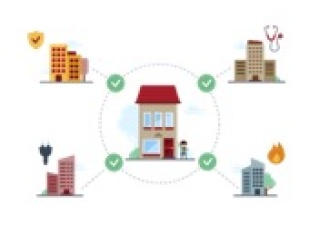Resident participation in the Digital Trust Infrastructure
26-07-2021

In this blog we share our latest findings from the first phase of the Digital Trust Infrastructure (DTI) project, which concerns a facility for the secure and responsible sharing of data. We discuss the results from the first phase of the DTI-project, from a resident perspective.
The Digital Home for sharing personal data in a secure way
Based on the need for a facility for secure and responsible sharing of data by residents in the context of the future energy market, years ago Alliander already started to invest in the development of the digital house. Various other applications for which this would have added value were defined, such as in the context of safety. Research via Facebook showed that people found it useful to provide emergency services with specific information in the event of an incident. In 2020 and 2021, in-depth interviews were conducted with individual residents, varying from young families with children, to people with a physical/medical disability and an older couple (>80). An overview of the retrieved functionality and preconditions is included in an appendix to the report on resident participation published here on Gitlab.
In recent months, work has been done on a demonstrator to demonstrate the Digital Trust Infrastructure (DTI) and the Digital House, based partly on the situation (use case) in which residents can make specific information available to the Fire Brigade when there is a fire in their home. The digital house is the part (building block) of the DTI that allows for the decentralized registration of permissions.
Resident participation
Parallel to the construction of the demonstrator, research was conducted into how residents can best be involved when the use case will be further developed into an interactive prototype on the DTI in a next phase. The result of this research is shared here. Subsequently, it was decided to take an in-depth look at the use case with a small, diverse, but digital-skilled group of residents, based on the assumption that their critical view of digital solutions and what is needed for trust can provide important broader insights.
Results of the final residents meeting
At the end of June there was a wrap-up meeting for collaborative brainstorming on the DTI and the follow-up based on the demonstrator. Even though it was a relative small group of residents, we are sharing the results here as these were both instructive and surprising qualitative insights, especially when it came to realizing a generic solution. This mainly concerned:
• Feasibility
A generic solution for sharing data in case of incidents was not considered feasible because it creates expectations that cannot be met on both the side of the emergency services and the residents. You cannot think of all scenarios in advance and process them in exhaustive lists. Long lists give the appearance of completeness and are difficult in the context of user-friendliness. You can ask open questions such as “What do you think is important for us to know about you?” but this is a complex question that everyone will answer in their own way. In addition, the fire service indicates that they do not actually want all the information. To prevent an information overload in the few minutes that they can prepare themselves before arrival on scene, but also because it can create the expectation that the fire service can take the shared information into account while this is not always the case
• Accuracy of information
It is unclear to what extent the shared information corresponds to the reality of that moment. For example, x people can be registered at an address, but who is actually at the moment of the incident (and maybe they rent out for holidays);
• Desirability
From the perspective of embedding public values, an alternative (analogue, such as paper) solution should be available, also as a fallback scenario. One resident asked: "is this the solution for the former list next to your door?" And also: “Doesn't it exclude people and make the situation unnecessarily complex?” The expectation was that a paper form, which one receives in the letterbox or Is included with a bought smoke detector, will probably be better adopted than an app that people have to be alerted to and then download and fill out.
Still, those involved did see added value. The presence of gas cylinders and stairlifts clearly turned out to be important information for emergency services and the willingness to share this information also appears to be high. The recommendation was to start with a specific, smaller target group for whom this possibility to securely share data is highly relevant and desirable. For example, people with a physical disability who cannot get out of their home independently (without an elevator). One of the participants also works for Clientenbelang, which represents the interests of this target group. He also added that people who are limited in something, often give up more privacy than average. For this target group, the DTI would be a solution that gives more control over data (autonomy) and to guarantee more privacy.
Another aspect that was emphasized, and also in line with previous interviews, is that residents and their neighbors themselves also like to be informed (push messages) that something is going on, so that they can respond with timely information and/or provide support. This can also be realized with the DTI.
As emerged from our research into involving residents, joint meetings with people from diverse backgrounds -including those with less digital skills- are also important for gaining new insights. Unfortunately, we have been somewhat limited in this by Covid as shifting from face-to-face interactions to digital means. The closing meeting described here also took place online. As a result, one of the attendees, despite having worked with video conferencing software before, was limited in participation because of the technology not working as expected.
Conclusion
This phase which was aimed at realizing a demonstrator, and meetings such as these, provided more than enough insights and starting points for a follow-up. First of all, the case in which residents with a physical disability are facilitated in enabling the sharing of data with emergency services in a safe and responsible manner. In additional discussion with the Digital life centre, people such as older adults are increasingly being offered digital (sensor) solutions in their homes for living longer independently, and consequently in the context of their physical safety. Due to the risks associated with data sharing, this could be at the expense of digital security. The DTI could ensure that the people who find these facilities necessary and/or helpful are also protected in the context of digital security.
Parties interested in further contributing to a prototype such as this context are welcome to contact the Digital Life Centre and/or DTI team.

